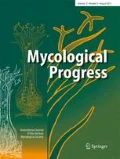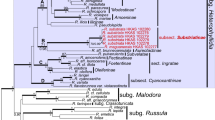Abstract
Russula lotus, R. nivalis, and R. purpureoverrucosa are proposed here as new taxa based on morphological and molecular evidences. The new species are described with illustration photographs and line drawings, and compared against related species. Morphologically, R. lotus (subgenus Heterophyllidia, section Heterophyllae, subsection Cyanoxanthinae) is characterized by a medium-sized basidioma with a pale pink to purplish pink pileus whose center area is yellowish white, white to cream white lamellae occasionally forked with lamellulae, a cream white smooth stipe, broadly ellipsoid to ellipsoid basidiospores ornamented with disconnected amyloid warts and inamyloid suprahilar plage, dispersed sulphovanillin (SV)-negative pileocystidia, and the pileipellis with suprapellis cells claw-assembled. Russula nivalis (subgenus Russula, section Russula, subsection Russula) is characterized by a very small pure white basidioma with a pileus 7–12 mm in diameter, abundant clavate pileocystidia and caulocystidia changing purplish red in SV, and broadly ellipsoidal to ellipsoid basidiospores ornamented with strongly amyloid warts and ridges interconnected by fine lines in an uncompleted or completed reticulum, mostly with inamyloid suprahilar plage. Russula purpureoverrucosa (subgenus Incrustatula, section Lilaceinae, subsection Lilaceinae) is characterized by a medium-sized basidioma with a red to grayish magenta pileus slightly areolate in small irregular warts from center to margin, a stipe with the same color and warts as the pileus, white to cream white occasionally forked lamellae with lamellulae, broadly ellipsoidal to ellipsoid basidiospores ornamented with amyloid warts and ridges rarely connected, abundant clavate pleurocystidia covered with thick yellowish incrustations, and the pileipellis with suprapellis cells a typical trichoderm, some of which covered with yellowish incrustations, pileocystidia absent. Phylogenetic analysis of nucleotide sequences of the internal transcribed spacer (ITS) region provided further evidence that the described species belong to the subsections above respectively, and represent new taxa.











Similar content being viewed by others
References
Bi ZS, Li TH (1986) A preliminary note on Russula species from Guangdong, with a new species and a new variety. Guihaia 6(3):193–199
Burlingham GS (1915) Russula. North American Flora 9:201–236
Burlingham GS (1924) Notes on species of Russula. Mycologia 16(1):20
Caboň M, Eberhardt U, Looney B, Hampe F, Kolařík M, Jančovičá S, Verbeken A, Adamčík S (2017) New insights in Russula subsect. Rubrinae: phylogeny and the quest for synapomorphic characters. Mycol Prog 16:877–892. https://doi.org/10.1007/s11557-017-1322-0
Chiu WF (1945) The Russulaceae of Yunnan. Lloydia 8:31–59
Das K, Dowie NJ, Li GJ, Miller SL (2014) Two new species of Russula (Russulales) from India. Mycosphere 5(5):612–622
Das K, Ghosh A, Li JW, Qiu LH, Baghela A, Halama M, Hembrom ME, Mehmood T, Parihar A, Pencakowski B, Bielecka M, Reczynska K, Sasiela D, Singh U, Song Y, Swierkosz K, Szczesniak K, Uniyal P, Zhang JB, Buyck B (2017) Fungal biodiversity profile 31–40. Cryptogam Mycol 38(3):1–54. https://doi.org/10.7872/crym/v38.iss3.2017.1
Doyle JJ, Doyle JL (1987) A rapid DNA isolation procedure for small quantities of fresh leaf tissue. Phytochem Bull 19:11–15
Dutta AK, Paloi S, Pradhan P, Acharya K (2015) A new species of Russula (Russulaceae) from India based on morphological and molecular (ITS sequence) data. Turk J Bot 39:850–856. https://doi.org/10.3906/bot-1407-1
Eberhardt U (2002) Molecular kinship analyses of the agaricoid Russulaceae: correspondence with mycorrhizal anatomy and sporocarp features in the genus Russula. Mycol Prog 1:201–223
Ghosh A, Das K (2017) Russula (Russulaceae) in western Himalaya 1: Two new species from subg. Russula. Phytoaxa 323(3). https://doi.org/10.11646/phytotaxa.323.3.3
Hall TA (1999) BioEdit: a user-friendly biological sequence alignment editor and analysis program for Windows 95/98/NT. Nucleic Acids Symp Ser 41:95–98
Hrynkiewicz K, Toljander YK, Baum C, Fransson PM, Taylor AF, Weih M (2012) Correspondence of ectomycorrhizal diversity and colonisation of willows (Salix spp.) grown in short rotation coppice on arable sites and adjacent natural stands. Mycorrhiza 22(8):603–613
Kirk PM, Cannon PF, Minter DW, Stalpers JA (2008) Dictionary of the fungi, 10th edn. CAB International, Wallingford
Kornerup A, Wanscher JH (1978) Methuen handbook of colour. Eyre Methuen, London
Li F (2011) Illustrated handbook of macrofungi from Heishiding. Sun Yat-Sen University Press, Guangzhou
Li F, Cai Q (2014) Amanita heishidingensis, a new species of Amanita sect. Lepidella from China. Mycol Prog 13:1191–1197. https://doi.org/10.1007/s11557-014-1008-9
Li GJ, Li SF, Wen HA (2010) The Russula species resource and its economic values of China. Acta Edulis Fungi 17(supl):155–160
Li GJ, Zhao Q, Zhao D, Yue SF, Li SF, Wen HA, Liu XZ (2013) Russula atroaeruginea and R. sichuanensis spp. nov. from southwest China. Mycotaxon 124:173–188. https://doi.org/10.5248/124.173
Li GJ, Zhao D, Li SF, Wen HA (2015) Russula chiui and R. pseudopectinatoides, two new species from southwestern China supported by morphological and molecular evidence. Mycol Prog 14:33. https://doi.org/10.1007/s11557-015-1054-y
Li F, Zhao K, Deng QL, Zhang M, Staehelin C, Chen XX, Chen HY, Wang GS, Li BS (2016) Three new species of Boletaceae from the Heishiding Nature Reserve in Guangdong Province, China. Mycol Prog 15:1269–1283. https://doi.org/10.1007/s11557-016-1233-5
Looney BP, Ryberg M, Hampe F, Sanchez-Garcia M, Matheny PB (2016) Into and out of the tropics: global diversification patterns in a hyper-diverse clade of ectomycorrhizal fungi. Mol Ecol 25(2):630–647. https://doi.org/10.1111/mec.13506
Melera S, Ostellari C, Roemer N, Avis PG, Tonolla M, Barja F, Narduzzi-Wicht B (2016) Analysis of morphological, ecological and molecular characters of Russula pectinatoides Peck and Russula praetervisa Sarnari, with a description of the new taxon Russula recondita Melera & Ostellari. Mycol Prog 16:117–134
Miller SL, Buyck B (2002) Molecular phylogeny of the genus Russula in Europe with a comparison of modern infrageneric classifications. Mycol Res 106(3):259–276
Nylander JAA (2004) MrModeltest v2 program distributed by the author. Uppsala University, Uppsala
Osmundson TW, Robert VA, Schoch CL, Baker LJ, Smith A, Robich G, Mizzan L, Garbelotto MM (2013) Filling gaps in biodiversity knowledge for macrofungi: contributions and assessment of an herbarium collection DNA barcode sequencing project. PLoS One 8(4):E62419
Palmer JM, Lindner DL, Volk TJ (2008) Ectomycorrhizal characterization of an American chestnut (Castaneadentata)-dominated community in western Wisconsin. Mycorrhiza 19(1):27–36
Paloi S, Dutta AK, Acharya K (2015) A new species of Russula (Russulales) from eastern Himalaya, India. Phytotaxa 234(3):257. https://doi.org/10.11646/phytotaxa.234.3.6
Paloi S, Dutta AK, Pradhan P, Roy A, Acharya K (2016) Russula buyckii, a new species of Russula subgen. Incrustatula from eastern Himalaya, India. Phytotaxa 252(2):123–130
Romagnesi H (1967) Russules d’Europe et d’Afique du Nord. Bordas, Paris
Ronquist F, Huelsenbeck JP (2003) MrBayes 3: Bayesian phylogenetic inference under mixed models. Bioinformatics 19(12):1572–1574. https://doi.org/10.1093/bioinformatics/btg180
Roody WC (2003) Mushrooms of West Virginian and the Central Appalachians. University Press of Kentucky, Lexingto
Sarnari M (1998) Monografia illustrate de genere Russula in Europa. Tomo Primo. AMB, Centro Studi Micologici, Trento
Shi XG, Ye CX (2014) Alta of spermatophyte from Heishiding. Higher Education Press, Beijing
Song B, Li TH, Wu XL, Li JJ, Shen YH, Lin QY (2007) Known species of Russula from China and their distribution. Journal of Fungal Research 5:20–42
Song J, Chen JJ, Wang M, Chen YY, Cui BK (2016) Phylogeny and biogeography of the remarkable genus Bondarzewia (Basidiomycota, Russulales). Sci Rep 6:34568. https://doi.org/10.1038/srep34568
Song Y, Li JW, Buyck B, Zheng JF, Qiu LH (2018) Russula verrucospora sp. nov. and R. xanthovirens sp. nov., two novel species of Russula (Russulaceae) from southern China. Cryptogam Mycol 39(1):129–142. https://doi.org/10.7872/crym/v39.iss1.2018.129
Tai FL (1979) Sylloge fungorum Sinicorum. Science Press, Beijing
Tamura K, Peterson D, Peterson N, Stecher G, Nei M, Kumar S (2011) MEGA5: molecular evolutionary genetics analysis using maximum likelihood, evolutionary distance, and maximum parsimony methods. Mol Biol Evol 28(10):2731–2739. https://doi.org/10.1093/molbev/msr121
Teasdale SE, Beulke AK, Guy PL, Orlovich DA (2013) Environmental barcoding of the ectomycorrhizal fungus Cortinarius. Fungal Divers 58(1):299–310
Thompson JD, Gibson TJ, Plewnlak F, Jianmougin F, Higgins DG (1997) The Clustal X windows interfaces: flexible strategies for multiple sequence alignment aided by quality analysis tools. Nucleic Acids Res 24:4876–4882. https://doi.org/10.1093/nar/25.24.4876
Vilgalys R, Hester M (1990) Rapid genetic identification and mapping of enzymatically amplified ribosomal DNA from several Cryptococcus species. J Bacteriol 172:4238–4246
Wang XH, Yang ZL, Li YC, Knudsen H, Liu PG (2009) Russula griseocarnosa sp. nov. (Russulaceae, Russulales), a commercially important edible mushroom in tropical China: mycorrhiza, phylogenetic position, and taxonomy. Nova Hedwigia 88:268–282
Wen HA, Ying JZ (2001) Studies on the genus Russula from China II. Two new taxa from Yunnan and Guizhou. Mycosystema 20(2):153–155
Yu SX, Li Y, Wang YF, Zhou CF (2000) The vegetation classification and its digitized map of Heishiding Nature Reserve, Guangdong I. the distribution of the vegetation type and formation (in Chinese). Acta Sci Nat Univ Sunyatseni 39(2):61–66
Zeng NK, Tang LP, Li YC, Tolgor B, Zhu XT, Zhao Q, Yang ZL (2013) The genus Phylloporus (Boletaceae, Boletales) from China: morphological and multilocus DNA sequence analyses. Fungal Divers 58(1):73–101
Zhang JB, Li JW, Li F, Qiu LH (2017) Russula dinghuensis sp. nov. and R. subpallidirosea sp. nov., two new species from southern China supported by morphological and molecular evidence. Cryptogam Mycol 38(2):1–13
Zhao Q, Li YK, Zhu XT, Zhao YC, Lang JF (2015) Russula nigrovirens sp. nov. (Russulaceae) from southwestern China. Phytotaxa 236(3):249–256
Acknowledgements
We are grateful to the following persons for their kind help: Prof. Zhu-Liang Yang and Dr. Gang Wu, Kunming Institute of Botany (Chinese Academy of Sciences), for preserving specimens of the three new species, and providing Russula specimens; Mr. Emanuele Campo, an amateur mycologist from Italy and Prof. Tai-Hui Li, Guangdong Institute of Microbiology, for providing valuable monographs on the genus Russula; Dr. Xiang-Hua Wang, Kunming Institute of Botany (Chinese Academy of Sciences) and Prof. Krishnendu Acharya, University of Calcutta, for scientific discussions and valuable suggestions; Dr. Jiao Qin, Kunming Institute of Botany (Chinese Academy of Sciences), Dr. Chao-Qun Wang, Guangdong Institute of Microbiology, and Mr. Gen-Shen Wang, Sun Yat-Sen University, for helping with using software for phylogenetic analyses; Prof. Christian Staehelin, Sun Yat-Sen University, for checking the Latin names; Prof. Li-Hong Qiu and Dr. Yu Song, Sun Yat-Sen University, for providing valuable literature on Russula; Prof. Zhi-Hui Deng, School of Foreign Languages, Sun Yet-Sen University, for checking the English; Ms. Zheng-Duan Xiao and Mr. Hao Huang (technicians), the Guangdong Institute of Microbiology and Dr. Xin-Yu Wang (technician), Kunming Institute of Botany (Chinese Academy of Sciences), for providing Russula specimens. Finally, we would like to thank three anonymous reviewers for their critical comments and suggestions to improve the manuscript. This study was financially sponsored by the School of Life Sciences, Sun Yat-Sen University.
Author information
Authors and Affiliations
Corresponding author
Additional information
Section Editor: Zhu-Liang Yang
Rights and permissions
About this article
Cite this article
Li, F., Deng, QL. Three new species of Russula from South China. Mycol Progress 17, 1305–1321 (2018). https://doi.org/10.1007/s11557-018-1447-9
Received:
Revised:
Accepted:
Published:
Issue Date:
DOI: https://doi.org/10.1007/s11557-018-1447-9




